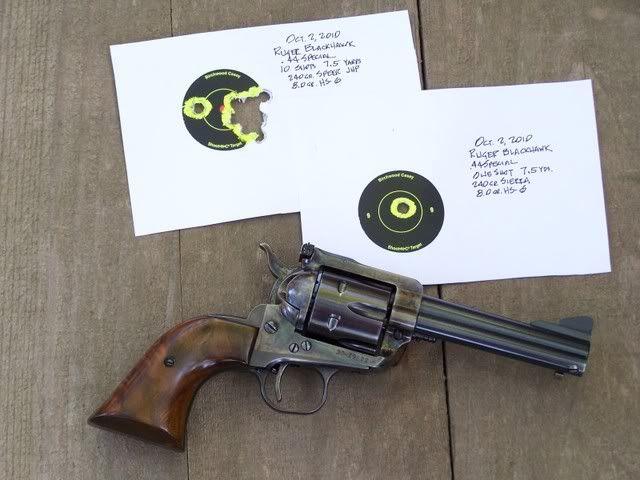Bob Wright
Hawkeye
I'm still a bit puzzled, though losing non sleep over it, about my recent experience with my .44 Specials. First this one, a Three Screw Blackhawk .357 Magnum re-born as a .44 Special:

And this Johnny-come-lately Flat Top:

I had been using SR-4756 for a long time, but when I heard it was to be discontinued, I worked up a good accurate load, using 8.0 grs. HS-6 with a 230 gr. cast SWC from Missouri Bullets.
Recetly I was given a partial box of Speer 240 gr. swaged SWCs, maybe 100 gone out of the box. So I loaded a few with my 8.0 grs. of HS-6, but loaded some with 7.0 grs. Winchester 231. I've used 231 with great success in the past, so knew it was a time proven powder.
On a recent trip to the range, using the Three Screw, I fired, alternately, ten shot groups at ten yards, using a 2 3/4" dia. stick-on target. The HS-6 load shot as expected, but the 231 load keyholed dramatically at that distance. Comments here on another post suggested undersized bullets, too soft lead, or barrel leading. Note these bullets were from the same box, and loads were fired alternately.
This past Saturday, I used the same two handloads, but switched guns, going to the Flat Top. The results were that both loads shot with very good accuracy with no sign of keyholing from the 231 load. The 231 load grouped very well, printing maybe 1/2" lower at that distance that the HS-6 load.
For some unexplained reason, the Three Screw just didn't like the Speer bullet and 7.0 grs. of Winchester 231.
A rather painful realization has surfaced in that I don't shoot as well as I once did. I seem to see the sights well enough, but age seems to have played tricks on my muscles!
Bob Wright

And this Johnny-come-lately Flat Top:

I had been using SR-4756 for a long time, but when I heard it was to be discontinued, I worked up a good accurate load, using 8.0 grs. HS-6 with a 230 gr. cast SWC from Missouri Bullets.
Recetly I was given a partial box of Speer 240 gr. swaged SWCs, maybe 100 gone out of the box. So I loaded a few with my 8.0 grs. of HS-6, but loaded some with 7.0 grs. Winchester 231. I've used 231 with great success in the past, so knew it was a time proven powder.
On a recent trip to the range, using the Three Screw, I fired, alternately, ten shot groups at ten yards, using a 2 3/4" dia. stick-on target. The HS-6 load shot as expected, but the 231 load keyholed dramatically at that distance. Comments here on another post suggested undersized bullets, too soft lead, or barrel leading. Note these bullets were from the same box, and loads were fired alternately.
This past Saturday, I used the same two handloads, but switched guns, going to the Flat Top. The results were that both loads shot with very good accuracy with no sign of keyholing from the 231 load. The 231 load grouped very well, printing maybe 1/2" lower at that distance that the HS-6 load.
For some unexplained reason, the Three Screw just didn't like the Speer bullet and 7.0 grs. of Winchester 231.
A rather painful realization has surfaced in that I don't shoot as well as I once did. I seem to see the sights well enough, but age seems to have played tricks on my muscles!
Bob Wright
